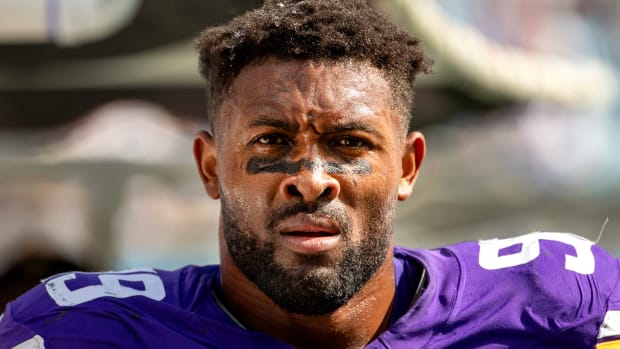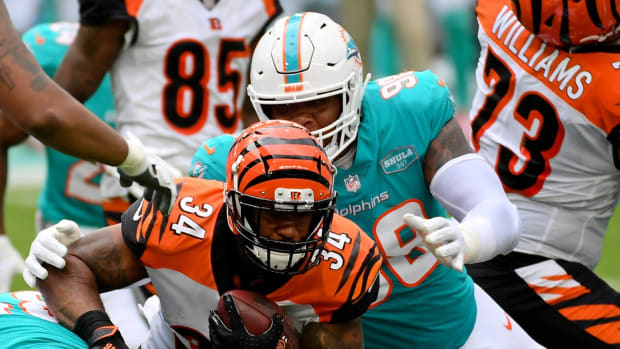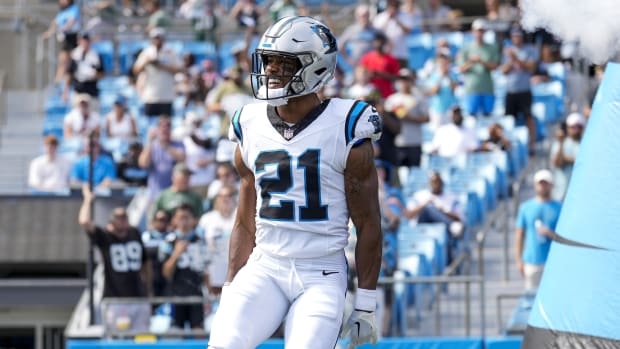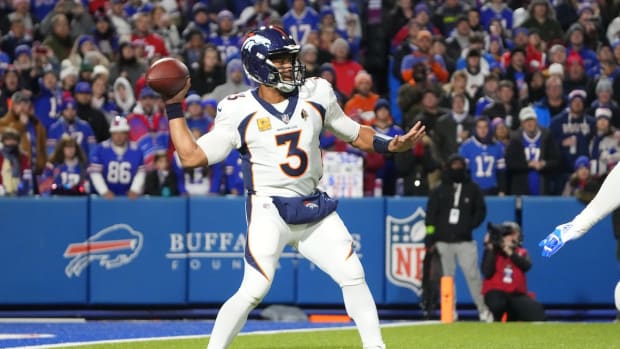Dez Could Be Done in Dallas, Biggest Pro Bowl Snubs, Gurley Is Great But Can’t be MVP
1. Dallas’s biggest need this offseason is wide receiver. Dez Bryant is no longer a No. 1 and shouldn’t remain on the roster with a 2018 cap number of $16.5 million. Since his dominant 2014 season, Bryant has looked sluggish in his transitional movement and build-up speed, and he was never a twitchy accelerator to begin with. He’s only 29; perhaps injuries are a factor. Whatever it is, his production has cratered. Since 2014 he has posted year-end receiving totals of 401 yards (nine games), 796 and, through 15 games this season, 815. He is averaging 54 yards an outing over that stretch, and lately, defenses have stopped dedicating extra safety help against him.
2. A huge element of New England’s offense that nobody talks about is “power,” where guard Joe Thuney or Shaq Mason pull-blocks in the run game. Tom Brady is great at throwing play-action off of this, usually to Rob Gronkowski on an inside route.
3. Vikings safety Harrison Smith is definitely the biggest Pro Bowl snub. Don’t be surprised if he’s voted first-team All-Pro. Another snub is Smith’s fellow safety, Andrew Sendejo, who has played a tick faster each week in his four years under Mike Zimmer. The interchangeability of Smith and Sendejo is the most important component of Minnesota’s scheme.
4. Offensively, the biggest Pro Bowl snub is Eagles center Jason Kelce, which is surprising given how fans have overrated him in recent years. The glaring weakness always overlooked was Kelce’s inability to sustain blocks against powerful defensive tackles who aligned head-up on him. This season, however, the Eagles have seen less of those fronts, and Kelce has had chances to get out in space—something he does better than any other center. He’s also been outstanding against defensive tackles aligned just to the left or right of him (in what’s called a “nose shade” technique). Kelce is the key piece to an Eagles rushing attack that, schematically, is the most diverse in football.
5. Todd Gurley has been tremendous, but you can’t vote him MVP. Much of his success stems from the Rams’ well-designed backfield passing game. Gurley, with his downhill rolling style, has made that backfield passing game better, but if you remove him, it wouldn’t hugely alter Sean McVay’s play-calling. If you took Le’Veon Bell off the Steelers, however, Todd Haley’s play-calling would change drastically. What Bell has that Gurley doesn’t is an ability to consistently create his own space. Bell is the NFL’s most valuable running back.
6. Along similar lines, Gurley’s teammate, Cooper Kupp, makes for an interesting Offensive Rookie of the Year debate. Kupp, like Gurley, has benefitted from great play designs, but Kupp’s balletic footwork and dependability have also amplified those designs. In New Orleans, though, Alvin Kamara’s unique ability has outright created new designs. It’s impossible to argue that Kamara isn’t more valuable, except when you consider that Kamara plays on just under half of New Orleans’ snaps, while Kupp has played more than 75% of Los Angeles’s (and in recent weeks, nearly 100 percent). How should Kupp’s quantity be weighed against Kamara’s quality?
NFL Black Monday Primer: Which Coaches Will Be Fired, and Who Will Fill The Vacancies
7. If the Falcons make the playoffs, the biggest concern is that we still haven’t seen great synchronization between their running game and passing game, which is why there have been fewer explosive plays and run-after-catch situations for them this season.
8. If the Seahawks make the playoffs, the biggest concern is that their offense doesn’t have many answers for zone coverage. The few staple play designs Seattle does have generally defeat man coverage, not zone. There’s an inherent inconsistency to an offense that’s built around its quarterback’s sandlot playmaking (a full explanation of that was recently published here—since then the Seahawks have posted 149 and 136 net yards in their last two games). That inconsistency magnifies when defenses sit back in two-deep zone.
9. The Ravens have finally found a smidgen of offensive consistency, and it’s due to calling more first-down passes. Joe Flacco has rediscovered his aggressiveness on intermediate play-action passes, where defensive looks are more predictable.
10. Cam Newton has long been the catalyst to Carolina’s rushing attack, but mostly as a decoy. This season, with the tailbacks not running particularly well, Newton has been the primary ballcarrier. In recent weeks, the Vikings, Packers and Bucs, from a down-to-down standpoint, kept Newton’s running in check. His numbers were still good thanks to a home run play or two—and home runs should certainly not be discounted. But if the Panthers are to advance come January, they’ll have to turn their many 2- to 4-yard carries into 5- to 7-yard carries, especially if they’re going to be as mediocre on third-and-medium as they were last week against Tampa Bay.
• Question or comment? Email us at talkback@themmqb.com.




































